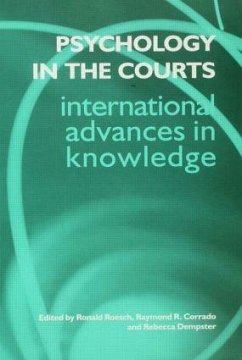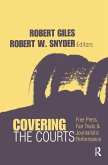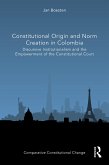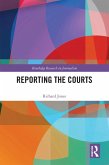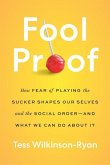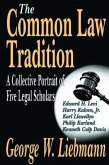Rebecca Dempster / Ronald Roesch (eds.)
Psychology in the Courts
Herausgeber: Corrado, Raymond R; Roesch, Ronald; Dempster, Rebecca
Rebecca Dempster / Ronald Roesch (eds.)
Psychology in the Courts
Herausgeber: Corrado, Raymond R; Roesch, Ronald; Dempster, Rebecca
- Gebundenes Buch
- Merkliste
- Auf die Merkliste
- Bewerten Bewerten
- Teilen
- Produkt teilen
- Produkterinnerung
- Produkterinnerung
Provides a useful overview of the latest research into the interaction between psychology and the courts.
Andere Kunden interessierten sich auch für
![Covering the Courts Covering the Courts]() Robert GilesCovering the Courts181,99 €
Robert GilesCovering the Courts181,99 €![Constitutional Origin and Norm Creation in Colombia Constitutional Origin and Norm Creation in Colombia]() Jan BoestenConstitutional Origin and Norm Creation in Colombia126,99 €
Jan BoestenConstitutional Origin and Norm Creation in Colombia126,99 €![Recognizing the Psychological and Cultural Strengths of Black Americans Recognizing the Psychological and Cultural Strengths of Black Americans]() Robert T CarterRecognizing the Psychological and Cultural Strengths of Black Americans180,99 €
Robert T CarterRecognizing the Psychological and Cultural Strengths of Black Americans180,99 €![Reporting the Courts Reporting the Courts]() Richard JonesReporting the Courts180,99 €
Richard JonesReporting the Courts180,99 €![Fool Proof Fool Proof]() Tess Wilkinson-RyanFool Proof25,99 €
Tess Wilkinson-RyanFool Proof25,99 €![The fraud of feminism The fraud of feminism]() Ernest Belfort BaxThe fraud of feminism13,99 €
Ernest Belfort BaxThe fraud of feminism13,99 €![The Common Law Tradition The Common Law Tradition]() George LiebmannThe Common Law Tradition181,99 €
George LiebmannThe Common Law Tradition181,99 €-
-
-
Provides a useful overview of the latest research into the interaction between psychology and the courts.
Hinweis: Dieser Artikel kann nur an eine deutsche Lieferadresse ausgeliefert werden.
Hinweis: Dieser Artikel kann nur an eine deutsche Lieferadresse ausgeliefert werden.
Produktdetails
- Produktdetails
- Verlag: Taylor & Francis
- Seitenzahl: 368
- Erscheinungstermin: 7. Juni 2001
- Englisch
- Abmessung: 235mm x 154mm x 25mm
- Gewicht: 635g
- ISBN-13: 9780415268929
- ISBN-10: 0415268923
- Artikelnr.: 22164132
- Herstellerkennzeichnung
- Libri GmbH
- Europaallee 1
- 36244 Bad Hersfeld
- gpsr@libri.de
- Verlag: Taylor & Francis
- Seitenzahl: 368
- Erscheinungstermin: 7. Juni 2001
- Englisch
- Abmessung: 235mm x 154mm x 25mm
- Gewicht: 635g
- ISBN-13: 9780415268929
- ISBN-10: 0415268923
- Artikelnr.: 22164132
- Herstellerkennzeichnung
- Libri GmbH
- Europaallee 1
- 36244 Bad Hersfeld
- gpsr@libri.de
Ronald Roesch, Raymond R. Corrado, Rebecca Dempster
Invited address; Part 1: Adolescents; 1: Toward an Expanded Definition of
Adolescent Competence in Legal Contexts; 2: Girls in Jail: Punishment or
Protection?; 3: Are Juveniles Getting a Fair Trial?: The Jury is Still Out;
Part 2: Juries; 4: Race and the Civil Jury: How Does a Juror's Race Shape
the Jury Experience?; 5: Juror Competence and Processing Style in Making
Sense of Complex Trial Information; 6: Effects of Criminal Motivation,
Ability, and Opportunity on Mock Jurors' Verdicts; Part 3: Civil and
Criminal Court; 7: Complex Medical Litigation and Hindsight Bias:
Strategies to Reduce Factfinders' Retrospective Attributions of Fault; 8: A
Comparison of American and Canadian Conceptualizations of Competence to
Stand Trial; 9: The Macarthur Competence Assessment Tool-Fitness to Plead:
Evaluation of a Research Instrument for Assessing Fitness to Plead; 10:
Public Opinion, Sentencing, and Parole: International Trends; 11: The
Syndrome Evidence Phenomenon: Time to Move On?; 12: Conditional Release
Attitudes: Laypersons' Perceptions of the Purposes, Effectiveness, and
Acceptability of Early Release by Offense Type 1; 13: Judges'
Decision-Making From Within; Part 4: Eyewitness Evidence and Testimony; 14:
Children's Recall of the Unfortunate Fakir: a Further Test of the Enhanced
Cognitive Interview; 15: Courtroom Pressures Can Alter Eyewitness
Confidence; 16: Creating Confusion: Unconscious Transference in Media Crime
Reporting; 17: The Discrimination of Deceptive, Mistaken, and Truthful
Witness Testimony; 18: Previous Exposure to the Sender's Behavior and
Accuracy at Judging Credibility; 19: The Influence of Personal
Characteristics, Stakes and Lie Complexity on the Accuracy and Confidence
to Detect Deceit 1; Part 5: Victims of Crime; 20: The Role of Social
Influence in Crime Victim's Decision to Notify the Police; 21: Structured
Trauma Writing (STW) as a Victim-Supportive Intervention: Examining the
Efficacy of Emotional Ventilation and Downward Writing 1
Adolescent Competence in Legal Contexts; 2: Girls in Jail: Punishment or
Protection?; 3: Are Juveniles Getting a Fair Trial?: The Jury is Still Out;
Part 2: Juries; 4: Race and the Civil Jury: How Does a Juror's Race Shape
the Jury Experience?; 5: Juror Competence and Processing Style in Making
Sense of Complex Trial Information; 6: Effects of Criminal Motivation,
Ability, and Opportunity on Mock Jurors' Verdicts; Part 3: Civil and
Criminal Court; 7: Complex Medical Litigation and Hindsight Bias:
Strategies to Reduce Factfinders' Retrospective Attributions of Fault; 8: A
Comparison of American and Canadian Conceptualizations of Competence to
Stand Trial; 9: The Macarthur Competence Assessment Tool-Fitness to Plead:
Evaluation of a Research Instrument for Assessing Fitness to Plead; 10:
Public Opinion, Sentencing, and Parole: International Trends; 11: The
Syndrome Evidence Phenomenon: Time to Move On?; 12: Conditional Release
Attitudes: Laypersons' Perceptions of the Purposes, Effectiveness, and
Acceptability of Early Release by Offense Type 1; 13: Judges'
Decision-Making From Within; Part 4: Eyewitness Evidence and Testimony; 14:
Children's Recall of the Unfortunate Fakir: a Further Test of the Enhanced
Cognitive Interview; 15: Courtroom Pressures Can Alter Eyewitness
Confidence; 16: Creating Confusion: Unconscious Transference in Media Crime
Reporting; 17: The Discrimination of Deceptive, Mistaken, and Truthful
Witness Testimony; 18: Previous Exposure to the Sender's Behavior and
Accuracy at Judging Credibility; 19: The Influence of Personal
Characteristics, Stakes and Lie Complexity on the Accuracy and Confidence
to Detect Deceit 1; Part 5: Victims of Crime; 20: The Role of Social
Influence in Crime Victim's Decision to Notify the Police; 21: Structured
Trauma Writing (STW) as a Victim-Supportive Intervention: Examining the
Efficacy of Emotional Ventilation and Downward Writing 1
Invited address; Part 1: Adolescents; 1: Toward an Expanded Definition of
Adolescent Competence in Legal Contexts; 2: Girls in Jail: Punishment or
Protection?; 3: Are Juveniles Getting a Fair Trial?: The Jury is Still Out;
Part 2: Juries; 4: Race and the Civil Jury: How Does a Juror's Race Shape
the Jury Experience?; 5: Juror Competence and Processing Style in Making
Sense of Complex Trial Information; 6: Effects of Criminal Motivation,
Ability, and Opportunity on Mock Jurors' Verdicts; Part 3: Civil and
Criminal Court; 7: Complex Medical Litigation and Hindsight Bias:
Strategies to Reduce Factfinders' Retrospective Attributions of Fault; 8: A
Comparison of American and Canadian Conceptualizations of Competence to
Stand Trial; 9: The Macarthur Competence Assessment Tool-Fitness to Plead:
Evaluation of a Research Instrument for Assessing Fitness to Plead; 10:
Public Opinion, Sentencing, and Parole: International Trends; 11: The
Syndrome Evidence Phenomenon: Time to Move On?; 12: Conditional Release
Attitudes: Laypersons' Perceptions of the Purposes, Effectiveness, and
Acceptability of Early Release by Offense Type 1; 13: Judges'
Decision-Making From Within; Part 4: Eyewitness Evidence and Testimony; 14:
Children's Recall of the Unfortunate Fakir: a Further Test of the Enhanced
Cognitive Interview; 15: Courtroom Pressures Can Alter Eyewitness
Confidence; 16: Creating Confusion: Unconscious Transference in Media Crime
Reporting; 17: The Discrimination of Deceptive, Mistaken, and Truthful
Witness Testimony; 18: Previous Exposure to the Sender's Behavior and
Accuracy at Judging Credibility; 19: The Influence of Personal
Characteristics, Stakes and Lie Complexity on the Accuracy and Confidence
to Detect Deceit 1; Part 5: Victims of Crime; 20: The Role of Social
Influence in Crime Victim's Decision to Notify the Police; 21: Structured
Trauma Writing (STW) as a Victim-Supportive Intervention: Examining the
Efficacy of Emotional Ventilation and Downward Writing 1
Adolescent Competence in Legal Contexts; 2: Girls in Jail: Punishment or
Protection?; 3: Are Juveniles Getting a Fair Trial?: The Jury is Still Out;
Part 2: Juries; 4: Race and the Civil Jury: How Does a Juror's Race Shape
the Jury Experience?; 5: Juror Competence and Processing Style in Making
Sense of Complex Trial Information; 6: Effects of Criminal Motivation,
Ability, and Opportunity on Mock Jurors' Verdicts; Part 3: Civil and
Criminal Court; 7: Complex Medical Litigation and Hindsight Bias:
Strategies to Reduce Factfinders' Retrospective Attributions of Fault; 8: A
Comparison of American and Canadian Conceptualizations of Competence to
Stand Trial; 9: The Macarthur Competence Assessment Tool-Fitness to Plead:
Evaluation of a Research Instrument for Assessing Fitness to Plead; 10:
Public Opinion, Sentencing, and Parole: International Trends; 11: The
Syndrome Evidence Phenomenon: Time to Move On?; 12: Conditional Release
Attitudes: Laypersons' Perceptions of the Purposes, Effectiveness, and
Acceptability of Early Release by Offense Type 1; 13: Judges'
Decision-Making From Within; Part 4: Eyewitness Evidence and Testimony; 14:
Children's Recall of the Unfortunate Fakir: a Further Test of the Enhanced
Cognitive Interview; 15: Courtroom Pressures Can Alter Eyewitness
Confidence; 16: Creating Confusion: Unconscious Transference in Media Crime
Reporting; 17: The Discrimination of Deceptive, Mistaken, and Truthful
Witness Testimony; 18: Previous Exposure to the Sender's Behavior and
Accuracy at Judging Credibility; 19: The Influence of Personal
Characteristics, Stakes and Lie Complexity on the Accuracy and Confidence
to Detect Deceit 1; Part 5: Victims of Crime; 20: The Role of Social
Influence in Crime Victim's Decision to Notify the Police; 21: Structured
Trauma Writing (STW) as a Victim-Supportive Intervention: Examining the
Efficacy of Emotional Ventilation and Downward Writing 1

